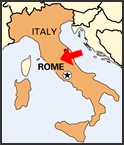
I sit on a train, coasting past farmland and lake water and the occasional highway. Ruins of old brick buildings are just as common a sight as occupied ones. So far, there are no farm animals to be seen, and at this time of year most fields are barren. We left Perugia, a city on a hill, and are en route to Florence to the north, in the Tuscany region. Perugia (Pear – ooh – juh) is the capital city of the Umbria region, and home to the Umbra Institute (their photos of the city), where Shaina is studying for the semester. Whilst Rome was grand and bustling, frequently dirty, with hundreds of idling police and thousands of tourists, Perugia is smaller, quieter, higher, and perhaps a bit more “real.” It is the right combination of historic and modern, with stone archways dating back to the 1400s in sight of the slick new “MiniMetro” mass-transit system, containing pods that comfortably hold 16 and come every minute along their eco-friendly route.
We stayed at the Brufani Hotel, an elegant affair with great views and the dubious distinction of playing host to Moussolini when he planned his march on Rome. It rests at the edge of Piazza Italia, a modern-looking square that leads to the town center, Piazza Quattro Novembre, a broad and bustling walk featuring outdoor dining, small shops, gelaterias, and the duomo, in a large open square with a fountain in the center. The steps of the church are referred to as das spiaggia — the beach of Perugia, with young people come to see and be seen, relax in the sun, and hang out with friends. The young men all wear leather jackets, the women skinny jeans. They do this on hot days, they do this on cold days. We are told that, while the duomo steps may be the town’s beach, wearing shorts and a tank top would bring “undue attention.”
Perugia is host to a gaggle of “personalities,” including the poet who wears two ties (because everyone else wears one!) and orates a daily polemic in one of the town squares. There are also several wild — or at least communal — dogs that roam the city center and poke their heads into shops. Like every Italian city, wild rose sellers roam the streets as well, assaulting women for euros, even venturing into restaurants to annoy diners.
Perugia has a thousand years of strife on its mind, but briefly: opposed the rise of papal dominion, was sacked by Catholic forces on a few occasions, and for a time played host to an imposing fortress that the Pope fled to in times of turmoil. When the Church left the city, the fortress was razed by the citizenry, and little of it remains. There is also a tradition of bread made without salt (it tastes terrible) due to the Papal salt tax that provided the justification for the first religious invasion. Sort of a very early precursor to the Boston Tea Party, but with far less favorable results for all involved. Shaina says that salt-free bread is common throughout Italy, which seems to me to be a dubious culinary choice in an age where salt is once again cheap and plentiful.
That reminds me: when it comes to the Church, modern Italy is 90% Catholic, at least nominally. Of course there are elegant historic churches situated every block in the big cities, not to mention lots of noisy early-morning church bells in the smaller ones. But religion here is no longer central to most people’s lives. Abortion is legal, for one thing, and nudity on TV is complemented by a cad prime minister married to a former model. One piece of advice for Italian travel: don’t take a train on Easter. Talk about bad travel planning.
While in Perugia, we experienced the best food of our entire Italian visit. I won’t name the restaurants, for fear that my tiny blog might somehow have a Rick Steves-like effect and ruin them (his recomendations have been universally terrible), but the trick is meeting up with someone who knows and has lived in the area. Since Shaina has gone to all of the trouble of sampling the cuisine and interacting with the locals, we were given the spoils of war — amazingly good pizza for lunch, a great traditional Italian dinner with her school friends one night, tasty sandwiches at a local deli, and an enchanting family dinner at a dark trattoria with all sorts of interesting specialities. At the final restaurant, we were given a single clay cup each and had to switch off between our house red vino and spring water. Every restaurant here has a house wine, almost always local to the region. Were I more of a wine conisseur, I would enjoy this more. For now I can appreciate the idea of it, if not the actual results.
We did not worry much about sightseeing in Perugia, except to drink in the magnificent views, do a bit of shopping, and wander the hills and steps a bit. This short slideshow hopefully captures a bit of the simplicity and natural beauty of the area.